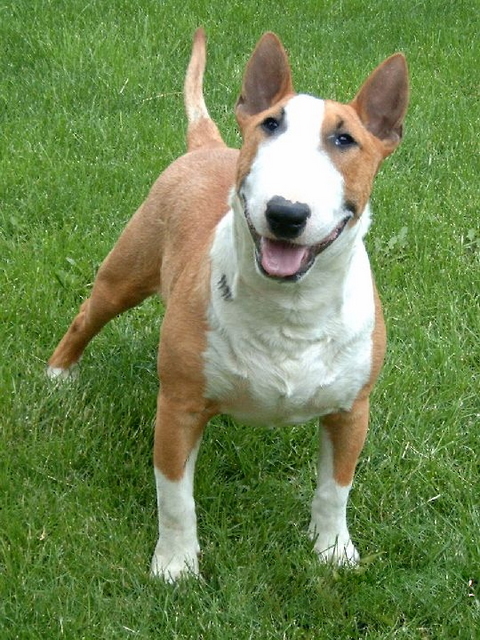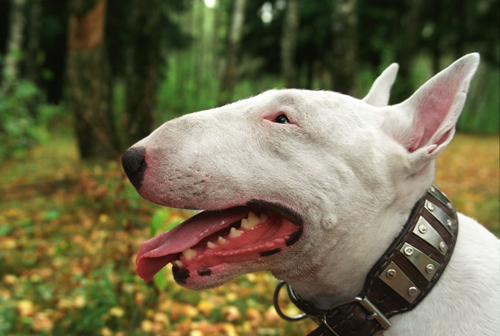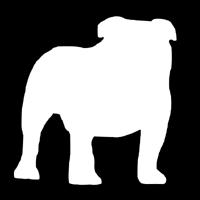

Description
The Bull Terrier's most recognizable feature is its head, described as 'egg shaped' when viewed from the front, almost flat at the top, with a Roman muzzle sloping evenly down to the end of the nose with no stop. The unique triangle-shaped eyes are small, dark, and deep-set. The body is full and round, while the shoulders are robust and muscular and the tail is carried horizontally. It walks with a jaunty gait, and is popularly known as the 'gladiator of the canine race'. There is no designated height or weight for the breed but the average is, Height: 51-61 cm (20-24 inches), Weight: 20-38 kg (44-85 pounds) The Bull Terrier and the Miniature Bull Terrier are the only recognized breeds that have triangle-shaped eyes.
Temperament
Though this breed was once a fierce gladiator, it is much gentler today. A Bull Terrier might have a preventive effect and it will certainly defend its owner in a truly critical situation. Bull terriers are known to be courageous, scrappy, fun-loving, active, clownish and fearless. The Bull Terrier is a loyal and polite dog. They become very attached to their owners. The Bull Terrier thrives on firm, consistent leadership and affection and makes a fine family pet. Bull Terriers like to be doing something and fit in well with active families where they receive a great deal of companionship and supervision. They do not do well in situations where they are left alone for 8 hours a day. This breed can be a wonderful pet if very thoroughly socialized and trained, but not recommended for most households. Fond of both grown-ups and children, but if they do not get enough physical and mental exercise they may be too energetic for small children. Children should be taught how to display leadership towards the dog. Meek owners will find them to become very protective, willful, possessive and or jealous. Bull Terriers may try to join into family rough housing or quarrel. Bull Terriers must be given a lot of structure. Be sure to socialize them well and remain their pack leader 100% of the time, otherwise, they can be extremely aggressive with other dogs. Unaltered males may not get along with other male dogs. Males and females can live together happily and two females can also be a good combination with care and supervision. They are not recommended with other non-canine pets such as hamsters and guinea pigs. They make excellent watch dogs.
Health
All puppies should be checked for deafness, which occurs in 20% of
pure white dogs and 1.3% of colored dogs and is difficult to notice, especially in a relatively young puppy.
Many Bull Terriers have a tendency to develop skin allergies. Insect bites, such as those from fleas, and
sometimes mosquitoes and mites, can
produce a generalized allergic response of hives, rash, and itching.
This problem can be stopped by keeping the dog free of contact from
these insects, but this is definitely a consideration in climates or
circumstances where exposure to these insects is inevitable. Their
lifespan is somewhere between 10 and 14 years,although they can live longer.
The Bull Terrier's coat is easy to maintain, but grooming can keep it in near-perfect condition. Adding oils to their meals can also vastly improve the quality of their coat. English Bull Terriers have thin, fine hair that requires minimal grooming. They are known to have light shedding patterns, they are also hypoallergenic. Another important issue is that any whiteness around the eyes, ears, nose, mouth, stomach or hindquarters with a short and sparse haired breed such as this must be protected against the sun with a gentle but high SPF factored sunscreen to prevent sunburn and subsequent cancer. The Bull Terrier requires a fair amount of exercise, but overworking the dog at a young age will cause strained muscles. Older dogs do require exercise, but in small doses, whereas younger ones will be happy to play for hours on end. The breed is renowned for being extremely greedy.
Common Ailments: Deafness, Umbilical Hernia and Acne. Bull Terriers can also suffer from obsessive compulsive disorder, such as tail chasing, self mutilation, and obsessive licking.


 TT
TT












